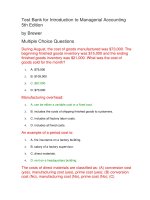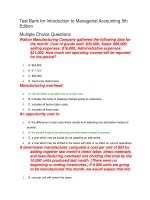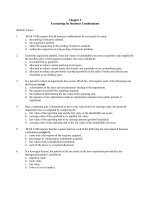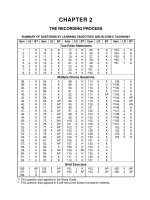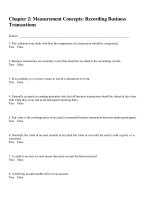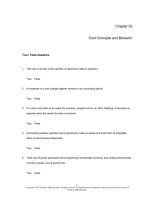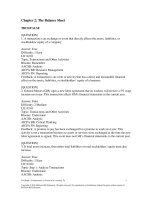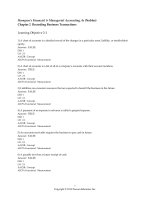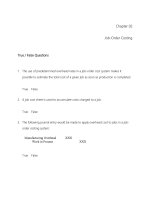Managerial accounting, 5th by jiambalvo test bank ch04
Bạn đang xem bản rút gọn của tài liệu. Xem và tải ngay bản đầy đủ của tài liệu tại đây (217.16 KB, 47 trang )
CHAPTER 4
Cost-Volume-Profit Analysis
Summary of Questions by Objectives and Bloom’s Taxonomy
Item SO
BT Item SO
True-False Statements
1.
1
K
11.
1
2.
1
K
12.
2
3.
1
K
13.
2
4.
1
K
14.
2
5.
1
K
15.
2
6.
1
K
16.
2
7.
1
K
17.
2
8.
1
K
18.
2
9.
1
K
19.
2
10.
1
K
20.
2
Multiple Choice Questions
48.
1
K
72.
2
49.
1
K
73. 2,A1
50.
1
K
74.
2
51.
1
K
75.
2
52.
1
K
76.
2
53.
1
K
77.
2
54.
1
K
78.
2
55.
1
K
79.
2
56.
1
AP
80.
2
57.
1
K
81.
2
58.
1
AP
82.
1
59.
1
K
83.
2
60.
1
C
84.
2
61.
2
K
85.
2
62.
2
K
86.
2
63.
2
K
87.
2
64.
2
K
88.
2
65.
2
K
89.
3
66.
2
K
90.
3
67.
2
K
91.
4
68.
2
K
92.
3
69.
1
C
93.
3
70.
2
AP
94.
3
71.
2
AP
95.
3
Matching
168. 1,2
3,5
K
BT
Item
SO
BT
Item
K
K
K
K
K
K
K
K
K
K
AP
AP
AP
AP
AP
AP
AP
AP
AP
K
K
C
K
K
AP
AP
AP
K
C
C
K
K
C
C
SO
BT
21.
22.
23.
24.
25.
26.
27.
28.
29.
30.
2
2
2
2
3
3
3
3
3
3
K
K
K
K
K
K
K
K
C
C
31.
32.
33.
34.
35.
36.
37.
38.
39.
40.
3
3
3
3
4
4
4
4
5
5
C
K
K
K
K
K
K
K
K
K
96.
97.
98.
99.
100.
101.
102.
103.
104.
105.
106.
107.
108.
109.
110.
111.
112.
113.
114.
115.
116.
117.
118.
119.
3
3
3
3
3
3
3
4
3
3
3
3
3
3
3
3
3
3
3
3
3
3
3
3
K
C
C
K
C
C
K
K
AP
AP
AP
AP
AP
AP
AP
AP
AP
AP
AP
AP
AP
AP
AP
AP
120.
121.
122.
123.
124.
125.
126.
127.
128.
129.
130.
131.
132.
133.
134.
135.
136.
137.
138.
139.
140.
141.
142.
143.
3
3
3
3
3
3
3
3
3
3
3
3
3
3
3
3
3
3
4
4
4
4
4
4
AP
AP
AP
AP
AP
AP
AP
AP
AP
AP
AP
AP
AP
AP
AP
AP
AP
AP
K
C
AP
AP
AP
AP
Item
SO
BT
41.
42.
43.
44.
45.
46.
47.
5
5
6
6
6
6
A1
K
C
K
K
K
K
K
144.
145.
146.
147.
148.
149.
150.
151.
152.
153.
154.
155.
156.
157.
158.
159.
160.
161.
162.
163.
164.
165.
166.
167.
4
6
6
4
6
4
4
3
5
5
5
5
5
5
3
3
5
5
6
6
2,A1
6
2,A1
6
AP
AP
AP
K
AP
AP
AP
AP
K
K
K
K
K
C
AP
AP
K
C
K
K
K
AP
AP
AP
4-2
Test Bank to accompany Jiambalvo Managerial Accounting, 5th Edition
Item SO
BT Item SO
Exercises
169.
1
K
173.
2
170.
2
AP 174.
3
171.
2
AP 175. 2,3
172. 2,3
AP 176.
3
Challenge Exercises
189.
6
AP 190.
4
Short-Answer Essays
193.
1
K
195.
2
194.
2
K
196.
2
BT
Item
SO
BT
Item
SO
AP
AP
N
AP
AP
177.
178.
179.
180.
AP
C
K
3
3
3
3
AP
AP
AP
AP
181.
182.
183.
184.
4
4
6
4
191.
2,3
AP
192. 1,2,3
AP
197.
198.
3
4
C
C
199.
K
5
BT
AP
AP
AP
AP
Item
185.
186.
187.
188.
SO
BT
5
6
2,A1
2,A1
AP
AP
AP
AP
Chapter 4 Cost-Volume-Profit Analysis
4-3
TRUE-FALSE
1.
Total variable costs change inversely with changes in volume or activity.
2.
Variable costs per unit remain the same when the level of activity changes within the relevant
range.
3.
Total fixed costs remain the same when the level of activity changes within the relevant range.
4.
Total variable costs remain constant across all levels of activity within the relevant range.
5.
Mixed costs are also referred to as semivariable costs.
6.
A step cost is similar to a variable cost, except that the relevant range is smaller for a step cost.
7.
Direct labor and manufacturing overhead costs are examples of fixed costs.
8.
The variable cost per unit is the same at all activity levels within the relevant range.
9.
Fixed costs are the same in total amount at any activity level within the relevant range.
10.
Committed fixed costs are costs that can be changed easily in a relatively brief period of time.
11.
Total production cost is generally a mixed cost.
12.
In order to use CVP analysis, costs must be separated into fixed and variable components.
13.
The account analysis method of estimating fixed and variable costs uses software programs such
as Microsoft Excel® to fit a line to multiple data points.
14.
The high-low method is subjective in that different managers viewing the same set of data may
select different data points to use in estimating costs.
15.
The high-low method is used to estimate a cost equation that can be used to predict costs at
estimated activity levels.
16.
The high-low method fits a straight line to the data points that represent the highest and lowest
cost levels of a particular activity.
17.
When using the high-low method, total fixed cost is found by calculating the intercept point of
the sloped line on the vertical axis.
18.
Total cost equals total fixed costs plus variable cost per unit times the activity level in units.
19.
Computer software is often used to conduct a regression analysis.
20.
Total costs and activity are assumed to have a linear relationship within the relevant range.
21.
Account analysis is a method used to estimate fixed and variable costs.
22.
A significant weakness of the high-low method is that the two data points chosen may not be
representative of the relationship between cost and activity.
4-4
Test Bank to accompany Jiambalvo Managerial Accounting, 5th Edition
23.
Regression analysis is a method of estimating the slope and y-intercept using all available data
points.
24.
Cost behavior patterns are assumed to be linear at all activity levels when a regression is used to
estimate cost behavior.
25.
Profit is equal to revenue minus total variable costs minus total fixed costs.
26.
At the break-even point, total revenue equals total fixed costs.
27.
The margin of safety is the difference between the current level of sales and break-even sales.
28.
Contribution margin is the difference between revenue and total costs.
29.
If the contribution margin ratio is 32%, this means that every $1.00 of sales will contribute $0.32
towards covering fixed costs and generating a profit.
30.
Contribution margin ratio is another name for the gross margin ratio.
31.
At the break-even point, total fixed costs equal total contribution margin.
32.
The margin of safety is the difference between the expected level of profit and break-even profit.
33.
If x = the number of units sold, profit = (contribution margin per unit × x) ‒ total fixed costs.
34.
The contribution margin ratio is determined by subtracting total costs from total sales revenue,
and then dividing by total sales revenue.
35.
When performing cost-volume-profit analysis with multiple products, it is assumed that the sales
mix remains constant, even when a different number of total units is are expected to be sold.
36.
CVP analysis for companies that sell more than one product assumes that the contribution margin
ratio for all products is the same.
37.
Total fixed costs divided by the contribution margin ratio equals the break-even point in sales
revenue.
38.
When performing multiple product CVP analysis, a necessary assumption is that sales mix,
variable cost per unit, and fixed cost per unit remain constant.
39.
Companies that have higher operating leverage find that their profit level is more responsive to
changes in sales volume than if operating leverage was low.
40.
Firms that have relatively high levels of variable costs have high operating leverage.
41.
Firms have no control over their level of operating leverage.
42.
If a company has only variable costs and its sales revenue increases by 20%, its profit will
increase by an amount larger than 20%.
43.
When dealing with a constrained resource situation, a company should generally produce only the
product with the highest contribution margin per unit in order to maximize profit
Chapter 4 Cost-Volume-Profit Analysis
4-5
44.
When dealing with a constrained resource situation, a company should generally produce only the
product with the highest contribution margin ratio, as this will insure the highest profit level.
45.
When there is a constraint on how many units can be produced, the focus shifts from contribution
margin per unit to contribution margin per unit of the constraint.
46.
Common constraints found in business that impact production include hours of labor, hours of
machine time, quantities of materials, and the cost of a product.
47.
The R Square is the slope of the regression line.
Answers
1
2
3
4
5
6
7
8
9
10
11
12
F
T
T
F
T
F
F
T
T
F
T
T
13
14
15
16
17
18
19
20
21
22
23
24
F
F
T
F
T
T
T
T
T
T
T
T
25
26
27
28
29
30
31
32
33
34
35
36
T
F
T
F
T
F
T
F
T
F
T
F
37
38
39
40
41
42
43
44
45
46
47
T
F
T
F
F
F
F
F
T
F
F
4-6
Test Bank to accompany Jiambalvo Managerial Accounting, 5th Edition
MULTIPLE CHOICE
48.
Which of the following is most likely to be a variable cost?
A.
Depreciation of a factory building
B.
Direct labor
C.
Factory janitor salaries
D.
Total costs of producing products
49.
Variable cost per unit
A.
can be estimated by performing break-even calculations.
B.
increases on a per unit basis when the level of activity increases.
C.
is represented by the slope of the total cost line.
D.
All of these answer choices are correct.
50.
Which of the following costs is least likely to be a variable cost?
A.
Sales commissions
B.
Direct labor
C.
Indirect materials
D.
Supervisory salaries
51.
When the level of activity decreases, total variable costs
A.
increase.
B.
remain the same.
C.
decrease in direct proportion to the decrease in activity.
D.
decrease, but at a slower rate than the level of activity.
52.
When the level of activity increases, the variable cost per unit
A.
decreases.
B.
remains constant within the relevant range.
C.
increases.
D.
fluctuates, depending on the amount of the increase in activity.
53.
When the level of activity increases, total fixed costs
A.
decrease.
B.
remain the same within the relevant range.
C.
decrease inversely with the change in activity.
D.
increase within the relevant range.
54.
When the level of activity increases, the fixed cost per unit
A.
decreases.
B.
remains the same.
C.
increases.
D.
fluctuates, depending on the amount of the increase in activity.
55.
Which of the following components are included in a mixed cost?
A.
A sunk cost and an opportunity cost
B.
A fixed cost and a variable cost
C.
A step cost and a semivariable cost
D.
A product cost and a period cost
Chapter 4 Cost-Volume-Profit Analysis
56.
4-7
Three costs incurred by Randall Rockers are summarized below at two different activity levels,
600 and 700 units:
600 Units
700 Units
Cost A
$2,700
$3,150
Cost B
2,940
3,360
Cost C
4,800
5,600
Which of these costs is variable?
A.
A, B, and C
B.
A and C
C.
A only
D.
C only
57.
Within the relevant range, variable costs
A.
per unit change when the activity level changes.
B.
are the same in total at different activity levels.
C.
are the same amount per unit at any activity level..
D.
None of these answer choices are correct.
58.
A cost is $4,900 at 800 units, $5,600 at 900 units, and $6,200 at 980 units. This cost is a
A.
variable cost.
B.
fixed cost.
C.
mixed cost.
D.
step cost.
59.
Step costs
A.
per unit are the same for each range of volume.
B.
are classified as step variable or step fixed depending on the range of activity for which
the cost remains fixed.
C.
change in total at every level of activity.
D.
are considered to be step fixed costs within a relatively small range.
60.
A company has a cost that is $7.00 per unit at a volume of 10,000 units and $5.00 per unit at a
volume of 14,000 units. What type of cost is this?
A.
Fixed costs
B.
Variable costs
C.
Mixed costs
D.
Incremental costs
61.
Which of the following is not a method that is used to estimate variable and fixed costs?
A.
Account analysis
B.
High-low method
C.
CVP analysis
D.
Regression analysis
62.
Which of the following is a cost estimation approach that is not based on fitting historical data
points to a line?
A.
Account analysis
B.
High-low method
C.
Regression analysis
D.
Margin of safety analysis
4-8
Test Bank to accompany Jiambalvo Managerial Accounting, 5th Edition
63.
The account analysis approach to estimating fixed and variable costs
A.
requires at least five years of historical data.
B.
is based on the professional judgment of the manager.
C.
is not useful for general and selling expenses.
D.
is only used if the data for the high-low method or regression analysis is not available.
64.
Walsh Company graphed its units produced and total production costs for the past eight months.
What is this called?
A.
Incremental analysis
B.
Regression analysis
C.
Contribution margin
D.
Scattergraph
65.
The high-low method calculates the total fixed cost as the
A.
difference between total variable costs and total costs at a particular activity level.
B.
difference between the unit variable cost and the unit total cost.
C.
change in cost divided by the change in activity level for two points.
D.
change in activity level divided by the change in cost for two points.
66.
A significant weakness of the high-low method is that
A.
a significant amount of management expertise is necessary to break out the variable and
fixed costs.
B. the two data points that are used may not be representative of the general relationship
between cost and activity.
C. the calculations are so complex that a computer is usually necessary in order to get accurate
results.
D.
monthly data must be collected for at least three years before the method can be used.
67.
Regression analysis
A.
uses all the available data points to estimate a cost equation.
B.
is less accurate than other methods of estimating costs.
C.
estimates a cost equation that indicates the variable and fixed costs per unit.
D.
is a method of determining the break-even point.
68.
The range of activity for which estimates and predictions are likely to be accurate is the
A.
incremental range.
B.
margin of safety.
C.
relevant range.
D.
range of opportunity.
69.
A cost is $34,500 at an activity level of 23,000 units, and $42,000 at an activity level of 28,000
units. What type of cost is this?
A.
Fixed costs
B.
Variable costs
C.
Mixed costs
D.
Sunk costs
Chapter 4 Cost-Volume-Profit Analysis
4-9
70.
Duradyne, Inc. has total costs of $18,000 when 2,000 units are produced and $26,000 when 5,200
units are produced. During March, 4,000 units were produced and sold for $8 each. If the highlow method is used, how much is the variable cost per unit?
A.
$2.50
B.
$0.40
C.
$2.00
D.
$4.00
71.
Ranger Pressure Cleaners has total monthly costs of $5,800 when 3,200 units are produced and
$6,425 when 3,700 units are produced. If the high-low method is used, how much is the estimated
total monthly fixed cost?
A.
$625
B.
$6,113
C.
$7,250
D.
$1,800
72.
C-Drive Components has collected the following production data for the past four months:
Units produced
Total cost
7,000
$16,500
10,000
22,500
8,500
17,750
9,000
21,000
If the high-low method is used, what is the monthly total cost equation?
A.
Total cost = $2,500 + ($2.00 × units produced)
B.
Total cost = $3,750 + ($2.75 × units produced)
C.
Total cost = $1,500 + ($2.00 × units produced)
D.
Total cost = $500 + ($2.25 × units produced)
73.
Management of MRC Enterprises has provided the following output from Excel ®:
SUMMARY OUTPUT
Statistics
Multiple R
0.8939072
R Square
0.7990702
Adjusted R2
0.7488377
Standard Error
10744.516
Observations
ANOVA
6
df
SS
MS
Regression
1
1836429
1836429
Residual
4
46177852
11544463
Total
5
2298208
Coefficients
Intercept
X Variable 1
Std Error
t Stat
F
15.90745
P-value
Significance
F
0.0162864
Lower 95%
Upper
95%
Lower
95%
Upper 95%
47757.05
34958.30
1.36611
0.24366
-49302.764
144816.88
49302.
144816.8
6.364
1.595798
3.98841
0.01628
1.9340590
10.795352
1.9340
10.79535
What is the estimated cost for a production level of 1,200 units?
A.
$1,730
4-10
Test Bank to accompany Jiambalvo Managerial Accounting, 5th Edition
B.
C.
D.
$55,394
$7,636
There is not enough information provided to determine the answer..
Chapter 4 Cost-Volume-Profit Analysis
4-11
74.
Total costs were $38,400 when 16,000 units were produced and $41,100 when 17,200 units were
produced. If the high-low method is used, how much are estimated total costs for a production
level of 17,100 units?
A.
$39,750
B.
$40,861
C.
$41,040
D.
$40,875
75.
Hardigree Insurance has collected the following information over the last six months.
Month
Units produced
Total costs
March
2,000
$6,700
April
3,200
9,400
May
2,200
7,100
June
3,000
9,500
July
2,800
8,000
August
2,100
6,600
Using the high-low method, how much is the variable cost per unit?
A.
$2.25
B.
$2.55
C.
$2.80
D.
$3.14
76.
Hardigree Insurance has collected the following information over the last six months.
Month
March
April
May
June
July
August
Units produced
2,000
3,200
2,200
3,000
2,800
2,100
Total costs
$6,700
9,400
7,100
9,500
8,000
6,600
Using the high-low method, how much is the total fixed cost?
A.
$2,300
B.
$2,200
C.
$4,400
D.
$7,910
77.
Hardigree Insurance has collected the following information over the last six months.
Month
March
April
May
June
July
August
Units produced
2,000
3,200
2,200
3,000
2,800
1,100
Total costs
$6,700
9,400
7,100
9,500
8,000
6,600
Using the high-low method, what is the estimated total cost in a month when 3,1300 units are
produced?
A.
$9,6259,175
B.
$9,5606,975
C.
$7,4254,732
D.
$7,2606,932
4-12
Test Bank to accompany Jiambalvo Managerial Accounting, 5th Edition
78.
Window Shine is aprovides window cleaning service. Information concerning costs and number
of windows cleaned for three months during 2014 appear below:
Month
May
July
September
Activity
18,000 windows
21,000 windows
20,400 windows
Cost
$84,000
94,500
94,800
Using the high-low method, what is the amount of total fixed costs?
A.
$10,500
B.
$3,000
C.
$21,000
D.
$78,857
79.
Princeton offers a large range of undergraduate courses. The University is interested in
determining the cost equation for the facilities cost as a function of student credit hours so that it
can more accurately budget its facilities costs as enrollment grows. Information for the high and
low cost semesters and volumes for last 5 years appears below:
Semester
Spring 2014
Fall 2017
Student Credit Hours
160,000
140,000
Facilities Cost
$750,000
$660,000
Using the high-low method, with student credit hours as the activity driver, what is the equation
for facilities cost (FC) as a function of student credit hours?
A.
FC = $4.50 / student credit hour
B.
FC = $1.14 / student credit hour
C.
FC = $30,000 + $4.50 / student credit hour
D.
FC = $568,182 + $0.22 / student credit hour
80.
A cost is $11,000 at 1,000 units, $12,000 at 2,000 units, and $13,000 at 3,000 units. Using the
high-low method, how much is the fixed portion of these costs?
A.
$1,000
B.
$10,000
C.
$20,000
D.
The answer depends on the actual activity.
81.
Which of the following methods provides the most accurate predictions of future costs?
A.
Account analysis.
B.
Scattergraphs.
C.
High-low method.
D.
Regression analysis.
82.
Which of the following correctly describes fixed and variable cost behavior as total volume
increases?
A.
Unit fixed costs stay the same and unit variable costs increase.
B.
Total fixed costs stay the same and total variable costs increase.
C.
Unit fixed costs decrease and total variable costs decrease.
D.
Unit fixed costs decrease and unit variable costs decrease.
Chapter 4 Cost-Volume-Profit Analysis
4-13
83.
Past relationships between cost and activity may not be a useful basis for estimating future costs
A.
if most of a company’s costs are variable.
B.
the company is able to accurately estimate its cost behavior.
C.
if the cost is a mixed cost.
D.
if future activity levels are expected to be beyond the relevant range.
84.
Which of the following methods requires the most professional judgment in classifying costs?
A.
Scattergraph
B.
Regression analysis
C.
Account analysis
D.
High-low method
85.
Each point on the scattergraph represents one pair of
A.
cost and activity values.
B.
variable cost and revenue values.
C.
fixed cost and revenue values.
D.
revenue and activity values.
86.
Carpet Renewal dyes carpets for residential customers. The company is interested in estimating
fixed and variable costs. The following data are available for the month of June when 420 carpets
were dyed:
Office rent
$ 1,250
Depreciation - equipment
900
Cleaning supplies
5,140
Hourly wages
11,000
Transportation (variable)
3,600
Owner’s salary
3,100
Total
$24,990
Using account analysis, how much is estimated variable cost per carpet?
A. $47.00
B. $38.43
C. $59.50
D. $52.12
87.
Lawn Cut Perfection provided data concerning the costs incurred to mow residential lawns for
which customers pay $45 per mowing. Data for the past 7 months are as follows:
Number of lawns mowed
Mowing cost
January
200
$12,900
February
110
$8,120
March
150
$10,200
April
100
$8,200
May
220
$13,060
June
120
$8,400
July
210
$13,280
How much is the estimated variable cost of mowing one lawn using the high-low method?
A.
$43.00
B.
$40.50
C.
$44.90
D.
$51.60
4-14
Test Bank to accompany Jiambalvo Managerial Accounting, 5th Edition
88.
Lawn Cut Perfection provided data concerning the costs incurred to mow residential lawns for
which customers pay $45 per mowing. Data for the past 7 months are as follows:
Number of lawns mowed
Mowing cost
January
200
$12,900
February
110
$8,120
March
150
$10,200
April
100
$8,200
May
220
$13,060
June
120
$8,400
July
210
$13,280
How much are the estimated monthly fixed costs using the high-low method?
A.
$8,200
B.
$2,444
C.
$4,150
D.
$3,180
89.
What are the three elements of the profit equation?
A.
Selling price per unit, variable cost per unit, and fixed cost per unit
B.
Total revenues, total variable costs, and total fixed cost
C.
Selling price per unit, variable cost per unit, and total fixed costs
D.
Selling price per unit, total variable costs, and fixed cost per unit
90.
What must be true if the contribution margin is less than zero?
A.
The selling price per unit is less than the variable cost per unit
B.
Total fixed costs will be greater than total variable costs.
C.
Not enough units were sold.
D.
Fixed costs plus variable costs are less than total revenue.
91.
Which of the following assumptions might negatively affect the validity of a CVP analysis?
A.
Costs can be accurately separated into fixed and variable components.
B.
Fixed costs remain fixed, and variable costs per unit do not change over the activity
levels of interest.
C.
Both the assumptions—costs can be accurately separated into fixed and variable
components, and fixed costs remain fixed, and variable costs per unit do not change over
the activity levels of interest—negatively affect the validity of a CVP analysis.
D.
None of these answer choices are correct.
92.
Which of the following is not considered to be a ‘cost’ in cost-volume-profit analysis?
A.
Variable costs
B.
Fixed costs
C.
Opportunity costs
D.
Mixed costs
93.
Which of the following statements is correct?
A.
Total fixed costs are equal to revenue plus variable cost per unit times the quantity
produced.
B.
Profit is equal to total fixed costs plus revenue.
C.
Total fixed costs are equal to profit minus revenue.
D.
Profit is equal to revenue minus total variable costs minus total fixed costs.
94.
Which of the following will have no effect on the break-even point in units?
A.
The selling price increases.
B.
The variable cost per unit increases.
C.
The number of units sold declines.
D.
Total fixed costs increase.
Chapter 4 Cost-Volume-Profit Analysis
4-15
95.
Hanalei Fishing Trips is operating at its break-even point of 4,200 fishing trips per year. Which of
the following statements is true?
A.
The amount of the company’s total costs equals the amount of its revenues.
B.
The company’s fixed costs equal its variable costs.
C.
The company’s profit is equal to its contribution margin.
D.
Assuming no other changes, if the company sold fewer trips, it will earn a higher
contribution margin per trip.
96.
The margin of safety is the difference between
A.
total revenue and total fixed costs.
B.
expected level of sales and the break-even point in revenue dollars.
C.
expected profit and profit at break-even.
D.
selling price and variable cost per unit.
97.
IM Enterprises sells two products, Crunchies and Munchies. Crunchies have a 32 percent
contribution margin and Munchies have a 35 percent contribution margin. Profit earned from
each box of Crunchies is $8 and the profit earned from each box of Munchies is $7. If the
company is planning to generate revenue of $100, what should the company do?
A.
It should sell more Crunchies.
B.
It should sell more Munchies.
C.
It should sell an equal number of each product.
D.
No recommendation can be made from the data given.
98.
If the contribution margin is greater than zero,
A.
the selling price of each product is less than the variable cost per unit.
B.
total variable costs are less than sales revenue.
C.
the company will be profitable.
D.
the fixed costs are greater than variable cost.
99.
The incremental profit generated by the sale of one additional unit is equal to the
A.
contribution margin per unit.
B.
selling price.
C.
margin of safety.
D.
incremental cost.
100.
Which of the following statements regarding the contribution margin ratio is not true?
A.
The contribution margin ratio is equal to the contribution margin per unit divided by the
selling price per unit.
B.
The contribution margin ratio is the amount of each sales dollar that goes toward
covering fixed costs and generating a profit.
C.
The contribution margin ratio is equal to variable cost per unit divided by fixed cost per
unit.
D.
The contribution margin ratio is useful when companies that sell a variety of products
calculate a break-even point in sales.
101.
Holding all other factors constant, the break-even point will decline if
A.
fixed costs increase.
B.
the contribution margin per unit increases.
C.
the selling price declines.
D.
the number of units sold decreases.
4-16
Test Bank to accompany Jiambalvo Managerial Accounting, 5th Edition
102.
Which of the following is not involved in determining the break-even point?
A.
Anticipated sales for the next period
B.
Total fixed costs
C.
Selling price per unit
D.
Variable cost per unit
103.
Which of the following is not an assumption of CVP analysis?
A.
Costs can be accurately separated into fixed and variable components.
B.
Fixed costs per unit remain constant within the relevant range.
C.
Total variable costs are proportional to the level of activity.
D.
Selling price per unit remains the same at all activity levels.
104.
Diva Products produces scarves. The estimated fixed costs for the year are $164,500, and the
estimated variable costs per unit are $9. The company expects to produce and sell 40,000 scarves
at a unit selling price of $16 per unit. How much is the break-even point in units?
A.
6,580 units
B.
10,300 units
C.
23,500 units
D.
376,000 units
105.
Diva Products produces scarves. The estimated fixed costs for the year are $164,500, and the
estimated variable costs per unit are $9. The company expects to produce and sell 40,000 scarves
at a unit selling price of $16 per unit. By how much can sales revenue drop before Diva Products
incurs a loss?
A.
$16,500
B.
$264,000
C.
$23,500
D.
$115,500
106.
At Bahama Foods, the break-even point is 1,600 units. If fixed costs total $44,000 and variable
costs are $12 per unit, what is the selling price per unit?
A.
$15.50
B.
$39.50
C.
$63,200
D.
There is not enough information provided to determine the answer.
107.
Widgely Sales Company’s break-even point is 12,200 units. Each unit incurs variable costs of
$2.20 and is sold for $4.90. How much are total fixed costs?
A.
$24,400
B.
$26,840
C.
$59,780
D.
$32,940
108.
Splurge Electronics sells homework machines for $80 each. Variable costs per unit are $45 and
total fixed costs are $43,750. Splurge is considering the purchase of new equipment that would
increase fixed costs to $48,700, but decrease the variable costs per unit by $5. At that level,
Splurge Electronics expects it can sell 1,500 units next year. What is the company’s break-even
point in units if it purchases the new equipment, assuming the selling price remains constant?
(Round your answer to the nearest whole number.)
A.
1,250 units
B.
1,218 units
C.
650 units
D.
2,312 units
Chapter 4 Cost-Volume-Profit Analysis
4-17
109.
Splurge Electronics sells homework machines for $80 each. Variable costs per unit are $45 and
total fixed costs are $43,750. Splurge Electronics expects it can sell 1,500 units next year. By how
many units can Splurge’s sales drop before the company incurs a loss?
A.
110 units
B.
1,250 units
C.
16 units
D.
250 units
110.
Oak Hill Furniture has a contribution margin ratio of 20%, and a contribution margin per unit of
$12. If fixed costs are $156,000, how much sales revenue must the company generate in order to
reach its break-even point?
A.
$780,000
B.
$13,000
C.
$15,600
D.
$31,200
111.
Randolph Corporation sells a single product at a price of $275 per unit. Variable cost per unit is
$135 and fixed costs total $356,860. If sales are expected to be $825,000, what is the company’s
margin of safety?
A.
$468,140
B.
$124,025
C.
$700,975
D.
$405,000
112.
MDI Enterprises prepared the following income statement for June:
Sales revenue (6,000 units)
Cost of goods sold:
Fixed costs
Variable costs
Gross profit
Operating expenses:
Fixed costs
Variable costs
Operating income
$150,000
$18,000
30,000
27,000
12,000
48,000
102,000
39,000
$ 63,000
How much is MDI’s total contribution margin?
A.
$120,000
B.
$108,000
C.
$105,000
D.
$93,000
113.
One Finger Staples produces a single stapler that it sells for $15 per unit. If variable costs per unit
are $6 and fixed costs total $42,300, how many units must the company sell in order to earn a
profit of $12,150?
A.
3,350 units
B.
4,700 units
C.
3,630 units
D.
6,050 units
4-18
Test Bank to accompany Jiambalvo Managerial Accounting, 5th Edition
114.
The president of DynaMark will not receive a bonus next year unless the company’s profits are at
least $435,000. DynaMark sells a single product at a price of $27 per unit. If variable costs are
$12 per unit and fixed costs total $150,000, what amount of unit sales must DynaMark generate
in order for the president to receive a bonus?
A.
48,750 units
B.
39,000 units
C.
29,000 units
D.
21,167 units
115.
MDI Enterprises prepared the following income statement for June:
Sales revenue (6,000 units)
$150,000
Cost of goods sold:
Fixed costs
$18,000
Variable costs
30,000
48,000
Gross profit
102,000
Operating expenses:
Fixed costs
27,000
Variable costs
12,000
39,000
Operating income
$ 63,000
How many units must MDI sell in order to break-even?
A.
2,500 units
B.
900 units
C.
3,480 units
D.
There is not enough information provided to determine the answer.
116.
WayFair Clothing has total fixed costs of $34,000 per month. It sells a single product with
variable costs of $5.60 per unit. If 8,000 units can be sold this month, what price must Wayfair
charge in order to break-even?
A.
$4.25
B.
$5.60
C.
$9.85
D.
There is not enough information provided to determine the answer.
117.
Revert Creations sells a single product at a price of $50 per unit. Fixed costs total $312,000 and
variable costs per unit are $24. Revert is considering the purchase of new equipment that would
reduce variable costs per unit to $21, but fixed costs would increase to $334,370. Above what
volume would Revert be profitable with the new machine, assuming the selling price remains
constant?
A.
12,000 units
B.
11,530 units
C.
23,530 units
D.
There is not enough information provided to determine the answer.
118.
SkyBucks Bagels sells boxes of bagels each with a variable cost of 45% of sales. Its fixed costs
are $36,000 per year. Each box has a contribution margin of $8. How much sales revenue does
SkyBucks need to break-even per year if bagels are its only product?
A.
$65,455
B.
$80,000
C.
$4,500
D.
$19,800
Chapter 4 Cost-Volume-Profit Analysis
4-19
119.
Plant Bottling needs to reduce the selling price of its acrylic water bottles in order to be
competitive. Currently, it has fixed costs of $110,000 and variable costs per unit of $4.10. If Plant
Bottling can sell 40,000 units, what price should it charge in order to break-even?
A.
$4.10
B.
$2.75
C.
$6.85
D.
None of these answer choices are correct.
120.
Rogers Racers makes toy race cars that sell for $12 each with a variable cost of $5 per car. Annual
fixed costs are $7,000. How much will profit increase if 600 more units are sold?
A.
$7,200
B.
$4,200
C.
$1,000
D.
$3,000
121.
Rogers Racers makes toy race cars that sell for $12 each with a variable cost of $5 per car. Annual
fixed costs are $7,000. How many cars must be sold to earn a profit of $3,150?
A.
1,450 cars
B.
450 cars
C.
263 cars
D.
550 cars
122.
Rogers Racers makes toy race cars that sell for $12 each with a variable cost of $5 per car. Annual
fixed costs are $7,000. If Rogers Racers sells 50 units fewer than break-even, how much loss
would the company recognize on its income statement?
A.
$350
B.
$4,200
C.
$250
D.
$70
123.
Angel Toys is a producer of tiny dolls for children. Following is information about its revenue
and cost structure:
Selling price per doll
Variable costs per doll:
Production (manufacturing costs)
Selling and administration (non-manufacturing costs)
Total fixed costs:
Production (manufacturing costs)
Selling and administration (non-manufacturing costs)
In which range does the break-even point fall?
A.
Between 5,000 and 6,000 units
B.
Between 6,000 and 7,000 units
C.
Between 10,000 and 11,000 units
D.
Between 11,000 and 12,000 units
$8.00
$1.20
$0.40
$40,000 per year
$32,000 per year
4-20
Test Bank to accompany Jiambalvo Managerial Accounting, 5th Edition
124.
Angel Toys is a producer of tiny dolls for children. Following is information about its revenue
and cost structure:
Selling price per doll
Variable costs per doll:
Production (manufacturing costs)
Selling and administration (non-manufacturing costs)
Total fixed costs:
Production (manufacturing costs)
Selling and administration (non-manufacturing costs)
$8.00
$1.20
$0.40
$40,000 per year
$32,000 per year
Management is proposing to pay sales people a commission equal to 10% of the variable
production cost. What will be the new contribution margin ratio if the commission plan is
implemented?
A.
70%
B.
80%
C.
78.5%
D.
The number of units to be sold is needed to determine the answer.
125.
Angel Toys is a producer of tiny dolls for children. Following is information about its revenue
and cost structure:
Selling price per doll
Variable costs per doll:
Production (manufacturing costs)
Selling and administration (non-manufacturing costs)
Total fixed costs:
Production (manufacturing costs)
Selling and administration (non-manufacturing costs)
$8.00
$1.20
$0.40
$40,000 per year
$32,000 per year
Assume that the current sales level is 14,000 dolls. What impact would a 10% increase in sales
have on income?
A.
Income would increase by 10%
B.
Income would increase by about 19%
C.
Income would increase by $11,200
D.
Income would increase by about 51%
126.
Angel Toys is a producer of tiny dolls for children. Following is information about its revenue
and cost structure:
Selling price per doll
Variable costs per doll:
Production (manufacturing costs)
Selling and administration (non-manufacturing costs)
Total fixed costs:
Production (manufacturing costs)
Selling and administration (non-manufacturing costs)
$8.00
$1.20
$0.40
$40,000 per year
$32,000 per year
Assume that sales are expected to fall from 14,000 units this year to 13,000 units next year. Angel
Toys would like to raise the selling price next year from the current $8.00 per unit to achieve the
same profits next year as the current year. What will the sales price have to be next year, to
generate the same profits next year as this year?
A.
Somewhere between $8.00 and $8.39
B.
Somewhere between $8.40 and $8.59
C.
Somewhere between $8.60 to $9.00
D.
Higher than $10.00
Chapter 4 Cost-Volume-Profit Analysis
127.
4-21
Charlie Shine has written a self-improvement book. The following are its pricing and cost details:
Selling price
Variable cost per unit:
Production
Selling & administrative
Fixed costs:
Production
Selling & administrative
$18.00 per book
$3.50
1.90
$33,600 per year
15,540 per year
How many books must Charlie sell to break-even?
A.
70,200 books
B.
3,900 books
C.
2,318 books
D.
2,667 books
128.
Charlie Shine has written a self-improvement book. The following are its pricing and cost details:
Selling price
$18.00 per book
Variable cost per unit:
Production
$3.50
Selling & administrative
1.90
Fixed costs:
Production
$33,600 per year
Selling & administrative
15,540 per year
What is the cost formula for this operation, where TC = Total cost and x = units sold?
A.
TC = 12.60x – 49,140
B.
TC = 6x + 49,140
C.
TC = 5.40x – 49,140
D.
TC = 5.40x + 49,140
129.
Charlie Shine has written a self-improvement book. The following are its pricing and cost details:
Selling price
Variable cost per unit:
Production
Selling & administrative
Fixed costs:
Production
Selling & administrative
$18.00 per book
$3.50
1.90
$33,600 per year
15,540 per year
Charlie Shine is currently selling 5,200 books per year. What impact would a 22% increase in
sales have on profit?
A.
Profit would increase by 22%.
B.
Profit would increase by 100%.
C.
Profit would increase by $20,592.
D.
Profit would increase by $14,414.
4-22
Test Bank to accompany Jiambalvo Managerial Accounting, 5th Edition
130.
Charlie Shine has written a self-improvement book. The following are its pricing and cost details:
Selling price
Variable cost per unit:
Production
Selling & administrative
Fixed costs:
Production
Selling & administrative
$18.00 per book
$3.50
1.90
$33,600 per year
15,540 per year
Assume the variable production cost and the selling price were each increased by $0.30 per book.
Which of the following would change?
A.
Contribution margin ratio
B.
Contribution margin per unit
C.
Break-even point in units
D.
Total fixed costs
131.
Talk Time Cellular sells smart phones for $150. The unit variable cost per phone is $25 plus a
selling commission of 10%. Fixed manufacturing costs total $5,600 per month, while fixed
selling and administrative costs total $2,100. What is the contribution margin per phone?
A.
$125
B.
$110
C.
$50
D.
There is not enough information provided to determine the answer.
132.
Talk Time Cellular sells smart phones for $150. The unit variable cost per phone is $25 plus a
selling commission of 10%. Fixed manufacturing costs total $5,600 per month, while fixed
selling and administrative costs total $2,100. How many phones must be sold to avoid a loss on
the company’s income statement?
A.
62 phones
B.
51 phones
C.
70 phones
D.
45 phones
133.
Talk Time Cellular sells smart phones for $150. The unit variable cost per phone is $25 plus a
selling commission of 10%. Fixed manufacturing costs total $5,600 per month, while fixed
selling and administrative costs total $2,100. Talk Time expects sales of $12,300 during next year.
How much is the margin of safety estimated for next year?
A.
$82
B.
$10,500
C.
$1,320
D.
$1,800
134.
Bunch of Books, a producer of children’s books, has provided the following information:
Selling price per unit
$6.60
Contribution margin per unit
$3.00
Total fixed costs
$46,200
What is the break-even point in books?
A.
20,790 books
B.
15,400 books
C.
12,833 books
D.
7,000 books
Chapter 4 Cost-Volume-Profit Analysis
4-23
135.
Brewster Café has estimated that fixed costs per month are $114,840 and variable cost per dollar
of sales is 42%. Sales during June totaled $220,000. What is the break-even point per month in
sales?
A.
$273,429
B.
$198,000
C.
$22,000
D.
None of these answer choices are correct.
136.
Brewster Café has estimated that fixed costs per month are $114,840 and variable cost per dollar
of sales is 42%. Sales during June totaled $220,000. What level of sales is needed for a monthly
profit of $31,900?
A.
$253,000
B.
$198,000
C.
$239,140
D.
$349,381
137.
Brewster Café has estimated that fixed costs per month are $114,840 and variable cost per dollar
of sales is 42%. For the month of July, the cafe anticipates sales of $300,000. What is the
expected level of profit?
A.
$126,000
B.
$59,160
C.
$174,000
D.
$11,160
138.
If a company sells many different types of products,
A.
it will have high operating leverage.
B.
the contribution margin ratio approach may be used to calculate the break-even point.
C.
it cannot use cost-volume-profit analysis.
D.
its margin of safety will be negative.
139.
A company that sells many different types of products should approach CVP analysis by
assuming that
A.
all products will have the same contribution margin ratio.
B.
products will be sold in a constant mix.
C.
fixed costs per unit will remain constant over the relevant range.the same number of
products will be sold each period.
D.
the company will sell equal amounts of each product each period.
140.
Tonto Rain Shields sells 3 types of umbrellas. Umbrella A sells for $20 and has variable cost of
$9.00 per unit. Umbrella B sells for $17.00 and has variable cost of $12.00 per unit. Umbrella C
sells for $9.00 and has variable costs of $6.00 per unit. The company sells in a mix of 2 units of
A, 3 units of B, and 5 units of C. What is the weighted average contribution margin per unit for
Tonto?
A.
$5.20
B.
$13.60
C.
$10.00
D.
$6.33
4-24
Test Bank to accompany Jiambalvo Managerial Accounting, 5th Edition
141.
Mexi-Foods produces tacos and burritos. Its financial information follows for the month of June:
Tacos
Burritos
Sales revenue
$40,000
$160,000
Fixed costs
8,000
40,000
Variable costs
15,000
75,000
Income
$17,000
$45,000
How much is the break-even point in total sales dollars for Mexi-Foods assuming the sales mix is
stable?
A.
$120,000
B.
$87,273
C.
$83,027
D.
None of these answer choices are correct..
142.
Beach Time produces two models of beach chairs, Lay Back and Easy Rest. Information
regarding these products for May follows:
Lay Back
Easy Rest
Number of units
6,000
14,000
Sales revenue
$120,000
$140,000
Fixed costs
24,000
50,000
Variable costs
60,000
42,000
Net Income
$ 36,000
$ 48,000
Selling price per unit
$20
$10
How much is Beach Time’s weighted average contribution margin ratio?
A.
60.00%
B.
32.31%
C.
60.77%
D.
71.53%
143.
Idol Creations produces two models of keyboards, compact and deluxe. Information regarding the
products is summarized for the month of April in the following table:
Number of units
Sales
Variable costs
Fixed costs
Profit
Profit per unit
Compact
600
$48,000
15,000
21,000
$12,000
$20.00
Deluxe
400
$36,000
12,000
20,000
$ 4,000
$10.00
Total
1,000
$84,000
27,000
41,000
$16,000
If the company’s weighted average contribution margin ratio is 67.86%, and the weighted average
contribution margin per unit is $57.00, how much will Idol Creation’s total sales be at breakeven?
A. $60,419
B. $122,281
C. $68,000
D. $60,552
Chapter 4 Cost-Volume-Profit Analysis
4-25
144.
Briggs Tools makes 2 products, snips and cutters. Snips have a contribution margin per unit of
$8.00 and cutters have a contribution margin per unit of $12.00. Briggs has annual fixed costs of
$117,600. Briggs’ historical sales data indicates that snips and cutters are sold in a 2 to 1 sale mix.
How many snips will be sold at break-even?
A.
4,200 snips
B.
8,400 snips
C.
14,700 snips
D.
12,600 snips
145.
Briggs Tools makes 2 products, snips and cutters. Snips have a contribution margin per unit of
$8.00 and cutters have a contribution margin per unit of $12.00. Briggs has annual fixed costs of
$117,600. Briggs’ historical sales data indicates that snips and cutters are sold in a 2 to 1 sale mix.
Each snip takes 2 machine hours and each cutter takes 4 machine hours. Demand for both
products is unlimited but the company must produce at least 1,000 units of each to stay
competitive. Briggs is limited to 24,000 machine hours per month. How many units of each
product should be produced each month?
A.
20,000 snips, 1,000 cutters
B.
10,000 snips, 4,000 cutters
C.
12,000 snips, 6,000 cutters
D.
10,000 snips, 1,000 cutters
146.
Yogurt Palace produces two flavors of low-fat frozen yogurt: Blueberry and Raspberry.
Information regarding the products is summarized for the month of January in the following
table:
Blueberry
Raspberry
Number of units
6,000
2,000
Sales revenue
$90,000
$20,000
Fixed costs
20,000
9,000
Variable costs
36,000
5,000
Profit
$34,000
$ 6,000
Amount of processing time per unit
1.4 hours
1.1 hours
Contribution margin per unit
$9.00
$7.50
Profit per unit
$5.67
$3.00
Yogurt Palace determined it will have only 9,040 hours of processing time during February for
which it can produce yogurt, and it must produce a minimum number of each flavor to remain
competitive. Of which flavor should Yogurt Palace produce the most units and why?
A. Raspberry. It will contribute a larger amount towards profit for each unit of resource
available.
B. Blueberry. It will contribute a larger amount towards profit for each unit of resource
available.
C. Blueberry. It generates a higher contribution margin per unit.
D. Raspberry. Fewer units will need to be produced using fewer hours, allowing excess hours for
other products.
147.
Which of the following is not an assumption underlying CVP analysis?
A.
Costs can be accurately separated into their fixed and variable components.
B.
Fixed costs remain constant over the relevant range.
C.
Variable costs per unit change over the relevant range.
D.
The sales mix remains constant.
